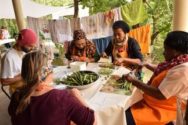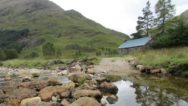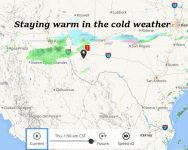
Drivin’ on up!
Eunice and I went on our very first weekend road trip last week! We went up to visit my Godfather, David who I reconnected with via the power of Facebook. I haven’t seen him since I was a very young child. He and his brother moved out to the west coast to pursue a career in bodybuilding. David has been back in the east coast for an artistic endeavor that’s nearing completion.
As a child, I would occasionally see him in magazines or on television and be so proud to be connected to him in some way even though he was never in my life the way Godfathers were supposed to be. He was a free-spirited young man living out his dream in L.A. and wasn’t very concerned at that point with fulfilling such a role for a little girl. It was a great disappointment growing up.
I’m no longer eight years old and since then, had suffered much deeper blows at the hands of family, thus making it easier to put past hurts behind me and reach out to him. After all, I was still so very intrigued and curious about this distant, mysterious figure that lingered in the background of my life.
I was nervous (something that rarely happens to me anymore), but when I finally saw him, he gave me a warm hug and that feeling quickly went away. David is definitely what someone would describe as “a character”… charismatic, light-hearted and somewhat eccentric. People around Providence call him “The Cowboy” because in a sea of conservatively dressed New Englanders, he stands out where ever he goes.
We took his Great Dane out for a long walk and had a good talk about his photography, my plans to venture west, and about the mechanics of life. He opened his home to me, made me awesome vegan dishes, baked for me, took me out to dinner, took me to the movies… and even made me the subject of an impromptu photo shoot! David spoiled me rotten the entire weekend. It was the first time in a very long time that I felt like the center of someone’s attention… almost like a kid! It was very well needed.
David and his dog Cowboy
After my weekender, I couldn’t help but feel that some sort of karma had been released from this experience, as I felt so much “lighter and brighter”. It was a rewarding first trip in which a connection was reestablished. It makes me wonder what other connections will be made in the time to come…
Side note: David may seem familiar to many of you (especially those of you who came of age during the 80’s & 90’s). That’s because he’s one half of The Barbarian Brothers!…

Whether you are an avid hunter or just love watching animals behaving normally in their natural habitat, you will want to read this.
A trail camera is a relatively low cost way to improve the efficiency of hunting as well as being the only way you can watch animals in their every day situations without disturbing them by your presence.
Trail cameras have huge possibilities for hunters. You can carry out a survey of the animal population in your chosen location, study the habits of your prey and even catch poachers and trespassers who have no right to be in the area. This last benefit is also one for animal lovers and vegans who wish to protect their local fauna from invasive hunting.
One thing to worry about is your beautiful new camera being stolen by other humans – whether they be hunters or just ramblers. That is why camouflage is an important consideration.
At around $150, one of the best buys is the Bushnell Trophy Cam Aggressor No Glow with Xtra Camo. As well as having excellent battery life and great night vision, it is also extremely hard to spot (other than when it actually goes off and uses the built in flash).
Choosing the best camera for your needs though leads you to consider the correct criteria. Features that matter most include portability, image resolution, night vision and storage space. To guide you in selecting the best option, have a look at this buyers’ guide .…

A clean, cheap and carbon neutral way to heat your home – sounds good. Its a reality for thousands of families and businesses in Europe and North America.
Pellet boilers are growing in popularity; with grants and incentives offered by various states and governments – often in the form of financial assistance towards equipment and installation, depending on location. Ecoheat Solutions, a pellet boiler provider, have put together a summary of incentives for US based consumers here.
Incentives vary by state, but there are options for either residential or commercial boilers. For example the state of New Hampshire offers 40% up to $10,000 towards equipment and installation providing the home has been heated by fossil fuels up to this point. For commercial purposes, the grant available rockets up to a potential $65,000 towards equipment and installation. The state of Vermont offers up to $2,000 towards equipment and installation for both residential and commercial properties providing that the boiler reduces fossil fuel usage. In New York, awards of up to $16,000 for residential properties are available dependent upon the size of the unit being installed. Commercial properties could receive up to $200,000 again dependent upon size.
If you’re located outside of the US do not despair – grants and incentives are available in a range of countries. Germany have a variety of incentives available for pellet boilers in residential properties with a minimum grants of between €3,000-3,500 for installation and equipment costs. Additional subsidies are also available if for instance the boiler is installed alongside a solar collector system or a heat pump or connected to a heating network. The ENOVA grant scheme in Norway allows a maximum refund of 10,000 Norwegian Krone for installation and components.
The UK has the Domestic Renewable Heat Incentive program. This is a government funded initiative which gives its participants quarterly payments for 7 years based on the amount of renewable heat their system produces. There is also a Non-Domestic scheme in place. Both schemes have different incentives and rules to abide by in order for participants to remain on the scheme. These rules include using the fuel type specified in the relevant emissions certificate and operating the boiler as outlined in the manufacturer’s guidelines. More information for applicants can be found here.
Pellet boilers function exactly like an oil or propane burner with fully automatic operation. The only difference being instead of oil, wood pellets are being used as the fuel. Pellets are a cleaner source of fuel, being completely carbon neutral. The reason for this is that for every tree burned as pellets, another tree is planted to take up the carbon released. Not only this but wood pellets are readily available in North America and Europe – a local renewable fuel source. This not only bolsters the local economy but pellets are also …
American families have been going off-grid for more than forty years, but for most it’s a gradual process, involving a lot of learning by trial and error. In a recent article published in Reason, J.D Tuccille wrote about how his experience going “semi-off-grid” in 2008 led him to reconsider his attachment to the mains, and begin a journey towards self-reliance that is still ongoing today.
Dipping into off-grid waters
In 2008 a power failure lasted a week at J.D’s former home in remote Arizona. While he had his own well, it was controlled by a pump that required electricity, and the surface of the water was too low to dip some out by hand. Then there was the issue of modern plumbing without electricity, and the requirements of coffee pots to consider. However, outages were common – so J.D had come prepared. He and his wife Wendy Wendy had stored water, cut firewood, and fueled up the camping stove and lanterns. They remained hydrated, warm and fed through that and every other experience with the electric grid’s unreliability.
“All in all, it was a bit Little House on the Prairie for our tastes, though with a better wine selection – but ultimately more of an inconvenience than a disaster,” he wrote. “But tolerance for inconvenience can decline with the years.”
When they moved to a new house in the foothills, Wendy had a strict requirement – a climate-controlled environment in the house at all times. This required some research into the best off-grid power systems to use for the climate, so J.D had to get serious.
“This being Arizona, where everything bakes for much of the year under the fireball in the sky, my first thought was solar,” J.D writes. “But I quickly discovered that all of those panels adorning people’s roofs were nothing more than expensive shingles during a power outage. Most solar installations are designed to feed the grid, not keep you independent of it. I priced adding batteries to the mix to gain some autonomy, but they more than doubled the cost. And batteries couldn’t handle the power demands of an air conditioner anyway. So we settled, if that’s the right word, for a 22 kW standby generator, which can handle the well pump and keep the air conditioning running.”
He said they were “especially pleased” with the decision when the European Union completed a coordinated cyber-attack simulation and found it leading to a “very dark scenario,” including crashed power grids.
J.D also beefed up the water storage capabilities at the house with rain barrels hooked to the gutters, which are conveniently located near the garden where he now grows tomatoes, olive and fig trees.
“Wendy and I have stumbled down our path incrementally over the years out of a combination of necessity and curiosity,” he writes. “We also keep tweaking our set-up. In addition …

Self-sustaining communities that can talk to each other; sounds like something from the future doesn’t it? But Regen Villages is making this a reality – right now. The first Regen eco-village has begun building works in Almere, 25 minutes from Amsterdam, the Netherlands. The 15,500m² project will house 100 families and aims to be completed by 2018.
Founded by James Ehrlich, a senior technologist at Stanford University, in 2015, Regen Villages has a holistic approach. A regenerative system combining new technology and renewable energy powered homes, with organic food production right on the doorstep.
The houses vary in size and are built inside a greenhouse “envelope”, with some even having terraces. Each home has a built in water collection system, solar panels and are passively heated. The community has a seasonal garden, biogas facility and aquaponics amongst other things.
The base of the villages is that the output of one system is the input to another. Waste from the homes is sorted into different categories. Bio-waste is used in the Biogas facility, whilst compost is used as food for livestock and small flies. The flies are fed to fish and the waste from both them and the livestock fertilises the seasonal gardens. The plants in the aquaponics facility and seasonal gardens produce fruit and vegetables for food, whilst the livestock and fish provide a source of protein. Rainwater is collected and stored at the houses and water produced at the biogas facility is also stored. Grey water is separated and used to irrigate the seasonal garden, whereas clean water is put into the aquaponics. Solar cells provide the energy for homes and also to the “smart grid” which can be used for charging electric cars.
Regen Villages, who are partnered with Danish architects EFFEKT, have been termed the “Tesla of ecovillages” paving the way for new innovative developments. Plans include villages being linked up to the cloud and being able to communicate with each other through the internet. In this way communities are self-reliant and off-grid but can still learn from each other.
At a conference held at Sliperiet, Umeå University, Sweden James Ehrlich spoke of the future for Regen Villages. After the completion of the Almere pilot, EU funding of a proposed 300 million euros (approximately $319 million) will enable projects in Sweden, Norway, Denmark and Germany to go ahead. These are aimed to be carried out during 2018-2022. Sights are then set on developments across Malaysia, Saudi Arabia, India, China and parts of the US, with government investments. As Ehrlich outlined, by targeting a challenging cold environment first, Regen Villages can be adapted to suit different climatic needs.
Off-grid sustainable greenhouse communities are not at all futuristic and Ehrlich is keen to make them a reality.…

Want to test out living off-grid but don’t want to do it alone? If you have $6000 to spare you can by taking part in the Permaculture and Ecovillage Immersion Experience with the School of Integrated Living (SOIL).
This two month residency running from June 10th to August 11th is less of a course and more of an eco-cultural learning experience.
Located in the ecovillage Earthaven near Asheville, North Carolina, you’ll gain new skills on a wide curriculum. From learning about ecological farming to efficient irrigation techniques and eco-spirituality, there is something for everyone. Most days will begin with a meditation session before getting stuck into the day. There will be unstructured time, but most weeks will cover approximately 50 hours of learning. A Permaculture Design Certification course is also included, which will take place in mid-June.
Earthaven was founded in 1994 and sits in 329 acres of land. A completely off-grid community powered with solar panels and two small hydropower stations. The buildings are made of environmentally friendly materials, usually lumber, with metal roofs for water catchment. Most are passively solar heated and propane burners help to keep them warm during colder months. The huts and residences have either individual or shared solar systems which supply their electricity. Batteries and generators are also charged by the micro hydropower stations for back up supplies. Although most of the residents get around by foot or bike, three solar powered golf carts can also be used.
Course participants will camp on site, with the majority of spots being for two person tents. A tarp covered kitchen with propane burners and a composting toilet are all available for use. Food is also included and most is sourced from the local environment and small farms in the village.
The cost of the course is $6,800 including tuition, food, camping, field trips and the permaculture design certificate. There is a $400 discount if booked before February 10th.
If you don’t want to spend two months at Earthaven but would still like to visit – you can! Workshops and tours are open to the public. Camping is also offered for $15 per adult per night, or $20 for two adults sharing a tent. The camping season runs from March 31st to November 5th.…

If you fancy buying an inexpensive off-grid getaway in Europe – try Scotland.
The government announced changes to their building regulations early this year. This will include huts of up to 30m² becoming exempt from regulations, specifically aimed at making it simple for people to achieve a life off the grid.
In a few months, you could be gazing out from a building like the one in the picture for less than $25,000 inclusive.
Scotland has a strong hutting culture dating back to the early 20th century; it was only 60 years ago that this began to dwindle. The largest remaining hut community in Carbeth, near Glasgow, managed to weather this decline. The community bought the land on which their 140 huts stand in 2013. But now resurgence is happening, thanks mainly to the campaign A Thousand Huts championed by the environment organisation Reforesting Scotland.
This organisation recognises the benefits of hut life, offering a retreat for rest, recreation, enjoying nature and making memories with family. Alongside use as a base for outdoor activities, huts contribute to sustainable development and encourage learning new skills. Reforesting Scotland have been lobbying for changes to the law for some time and are keen to encourage more people to adopt the hut lifestyle. Now changes to building regulations are being finalised this year, more people can benefit from having their own off-grid getaway.
Scottish planning (zoning) policy requires all developments to get planning permission for a new build from their local authority. This involves providing a description of plans on the chosen location. This part of the process will not change and will still have to take place.
However, single storey huts will no longer need a building warrant or have to comply with strict building regulations. This gives hut builders more freedom in how they build their huts and can significantly reduce building costs. There are still some rules which will have to be met.
Firstly, the build must fit the description of a hut as given in Scottish Planning Policy documents, which is as follows:
“A simple building used intermittently as recreational accommodation, having an internal floor area of no more than 30m²; constructed from low impact materials; generally not connected to mains water, electricity or sewage; and built in such a way that it is removable with little or no trace at the end of its life.”
By restricting size, the risk of structural instability of the hut is reduced but its energy efficiency is maximised.
Secondly, some health and safety regulations will have to be met, for example relating to fire risk and spread. A guidance document outlining these will be published by Reforesting Scotland later this year.
The Scottish Government has also allowed provision for a sleeping platform and amenities such as composting toilets within the hut. In terms of energy use and production, off-grid solutions such …


There are some things that can be (or look) fun about living off-grid, but there are many things that are less attractive, but still have to be done. One of those for us is truck maintenance. I rely on my truck for work and getting to town and back. We live some 20+ miles from the nearest town, what I tend to go through the most is tires and oil. Driving on the rough, unpaved, rocky, mountainous roads is very hard on tires as well as suspension. I drive slow to keep the damage at a minimum, but it still wears my tires out, I have to be prepared at any time to change a flat tire, and on occasion I have had to buy tires earlier than I wanted to because of having my spare on (in use) and getting another flat. I will need to look at buying tires once work starts building up again. Being in merchandising, our work slows down during the holidays, it’s about to pick up again and I can’t wait.
The other part of maintenance is oil changes, I have 2 choices, I can go in and pay to have it done in a garage, around here that is expensive, we’re talking about $60 or more, that’s just for a standard oil change and new filter, regular grade oil, nothing special. Or we can do it ourselves, like how I snuck in the “we”? Actually PB did it.
I ordered the oil and filter from Amazon, and I purchase an extra 2 quarts at a local store because my truck takes 7 quarts. It’s handy to be able to order most of what I need from Amazon, with the Prime service I have, I can get most things (including the oil and filter) here in 2 business days.
Yesterday, PB crawled under my truck and proceeded to change the oil, being able to do that ourselves saved us at least half what it would have cost to do it in town. I put a lot of miles on my truck so I need to get more regular oil changes, that will help keep my truck going for many years. One thing PB wants to do is incorporate a remote oil filter, that would allow me to use a larger filter, which would ultimately be safer for my truck, it’s something we will be looking into soon.

The other thing I did while the hood was up, I anointed the engine compartment with peppermint oil, it’s for the mice, out here in the country there is a terrible problem with rodents, they have a tendency to chew on things, and those things become expensive to repair, not to mention potentially being stranded somewhere because of an electrical problem. The mint is a rodent repellent, they don’t like it. Now my truck smells minty …
The Economist newspaper ran the foilowing report on the growth of survivalism in Idaho, Wyoming and Montana:
A movement of staunch conservatives and doomsday-watchers to the inland north-west is quietly gaining steam
ASKED by an out-of-stater where the nearest shooting range is, Patrick Leavitt, an affable gunsmith at Riverman Gun Works in Coeur d’Alene, says: “This is Idaho–you can shoot pretty much anywhere away from buildings.” That is one reason why the sparsely populated state is attracting a growing number of “political refugees” keen to slip free from bureaucrats in America’s liberal states, says James Wesley, Rawles (yes, with a comma), an author of bestselling survivalist novels. In a widely read manifesto posted in 2011 on his survivalblog.com, Mr Rawles, a former army intelligence officer, urged libertarian-leaning Christians and Jews to move to Idaho, Montana, Wyoming and a strip of eastern Oregon and Washington states, a haven he called the “American Redoubt”.
Thousands of families have answered the call, moving to what Mr Rawles calls America’s last big frontier and most easily defendable terrain. Were hordes of thirsty, hungry, panicked Americans to stream out of cities after, say, the collapse of the national grid, few looters would reach the mostly mountainous, forested and, in winter, bitterly cold Redoubt. Big cities are too far away. But the movement is driven by more than doomsday “redoubters”, eager to homestead on land with lots of water, fish, and big game nearby. The idea is also to bring in enough strongly conservative voters to keep out the regulatory creep smothering liberty in places like California, a state many redoubters disdainfully refer to as “the C-word”.
Estimates of the numbers moving into the Redoubt are sketchy, partly because many seek a low profile. Mr Rawles himself will not reveal which state he chose, not wanting to be overrun when “everything hits the fan”. But Chris Walsh of Revolutionary Realty says growing demand has turned into such a “massive upwelling” that he now sells about 140 properties a year in the north-western part of the Redoubt, its heart. To manage, Mr Walsh, a pilot, keeps several vehicles at landing strips to which he flies clients from his base near Coeur d’Alene.
Many seek properties served not with municipal water but with a well or stream, ideally both, just in case. More than nine out of every ten Revolutionary Realty clients either buy a home off the grid or plan to sever the connection and instead use firewood, propane and solar panels, often storing the photovoltaic power in big forklift batteries bought second-hand. They also plan to educate their children at home. The remoter land preferred by lots of “off-the-gridders” is often cheap. Revolutionary Realty sells sizeable plots for as little as $30,000. After that, settlers can mostly build as they please.
Lance Etche, a Floridian, recently moved his family into the Redoubt after the writings of …


As I sit here next to the wood burning stove, I am cozy warm inside of the SkyCastle. The temps are dropping and we just might have our first real cold snap of this winter later on today, at least that’s what the weather wizards keep saying. I have been watching the radar and there is wintry precipitation just north of us (that blue and pink stuff in the picture), but so far it hasn’t dropped south, maybe it will snow a bit in the morning, I don’t mind if it does, I have finished working for the week (it’s slow for merchandisers during the holidays), for me a nice snowy day means I’ll get to take some interesting pictures.
The SkyCastle is really simple to deal with in the cold, the wood burning stove keeps things warm enough inside, though we don’t try to keep things very warm, we dress warmly for the most part. Sleeping means bundling up in layers, I typically have thermals on (top and bottom) as well as thick PJs and regular socks & thick fuzzy socks. My blankets are also double duty, having a regular blanket that I sleep under year round, in winter I add a wool blanket, sometimes 2 of them, that is the real secret for me to keep warm in bed. I also utilize a hot water bottle. I know they are old fashioned, but by golly they work! I’ll usually put it next to my pillow with the blanket over it until I’m ready to get in bed, then I kick it down to the end of the bed to keep my feet warm. Having a warm dog is also another nice warm spot in the bed.
I found a couple of videos on how RV’ers keep warm in the winter. Honestly I don’t think I’d like living in a RV or camper in the winter if I had to be in a cold area, I think I understand why they move to warmer places in winter, those vehicles just aren’t meant for the cold IMHO.
I saw this video, thought it was interesting and decided to add it for you.
What about you? How do you keep warm in the winter?
…
Knots, everyone needs to know how to tie different kinds of knots, whether you are living off-grid, or in the big city, it’s a handy thing to know. I a woefully inadequate at tying knots, I will be watching the videos below and learning too. I am always impressed when I see someone tie a knot in some interesting and useful manner, it’s almost like performing magic (to those who don’t know how).
These two are longer more detailed videos
…